Ditapis dengan
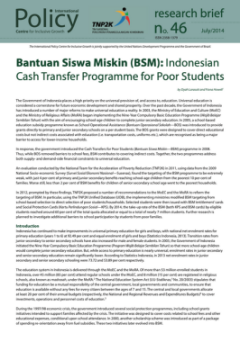
Bantuan Siswa Miskin (BSM): Indonesian Cash Transfer Programme for Poor Students
The Government of Indonesia places a high priority on the universal provision of, and access to, education. Universal education is considered a cornerstone for future economic development and shared prosperity. Over the past decade, the Government of Indonesia has introduced a number of major reforms to make universal education a reality. In 2003, the Ministry of Education and Culture (MoEC) …
- Edisi
- 1
- ISBN/ISSN
- -
- Deskripsi Fisik
- PDF, 6 Halaman
- Judul Seri
- Policy Brief
- No. Panggil
- 362.5 LAR.B
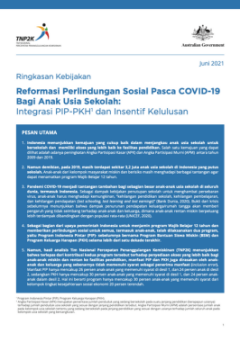
Ringkasan Kebijakan Reformasi Perlindungan Sosial Pasca COVID-19 Bagi Anak Us…
Indonesia menunjukkan perkembangan yang cukup baik dalam memenuhi target program Wajib Belajar 12 tahun selama satu dekade terakhir. Angka Partisipasi Kasar (APK) di tingkat Sekolah Menengah Pertama (SMP) dan Sekolah Menengah Atas (SMA) meningkat masing-masing dari 81,1 persen pada 2009 menjadi 90,6 persen pada 2019, dan dari 62,4 persen pada 2009 menjadi 84 persen pada 2019 (Susenas 2009, 2019…
- Edisi
- 1
- ISBN/ISSN
- -
- Deskripsi Fisik
- PDF, 12 Halaman
- Judul Seri
- Policy Brief
- No. Panggil
- 361.1 LAR.R
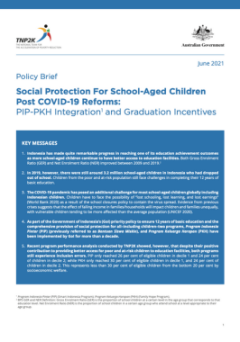
Social Protection For School-Aged Children Post COVID-19 Reforms: PIP-PKH Int…
Indonesia has made remarkable progress in meeting the target to provide 12 years of basic education for all over the decade to 2020. The gross enrolment ratio (GER) at junior secondary and senior secondary level increased from 81.1 per cent in 2009 to 90.6 per cent in 2019 and from 62.4 per cent in 2009 to 84.0 per cent in 2019 respectively (Susenas 2009, 2019). This achievement shows that more…
- Edisi
- 1
- ISBN/ISSN
- -
- Deskripsi Fisik
- PDF, 12 Halaman
- Judul Seri
- Policy Brief
- No. Panggil
- 361.1 LAR.S
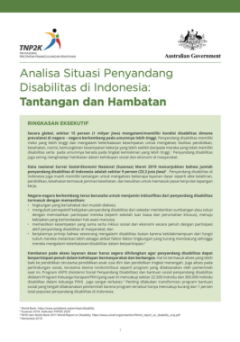
Analisa Situasi Penyandang Disabilitas di Indonesia: Tantangan dan Hambatan
Penyandang disabilitas di Indonesia tidak hanya menghadapi risiko ekonomi dan finansial yang besar, tetapi juga menghadapi tantangan besar dalam mengakses fasilitas dan layanan kesehatan serta pendidikan, perlindungan sosial dan memasuki pasar tenaga kerja. Sejak tahun 2018, Survei Sosial Ekonomi Nasional (Susenas) telah secara konsisten memasukkan Pertanyaan Disabilitas Kelompok Washington5 ya…
- Edisi
- 1
- ISBN/ISSN
- -
- Deskripsi Fisik
- PDF, 16 Halaman
- Judul Seri
- Policy Brief
- No. Panggil
- 371.9 SIY.A
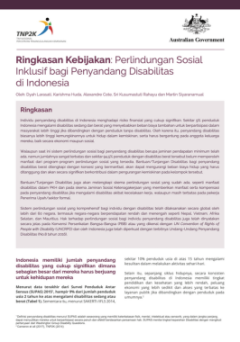
Ringkasan Kebijakan: Perlindungan Sosial Inklusif bagi Penyandang Disabilita…
Individu penyandang disabilitas di Indonesia menghadapi risiko finansial yang cukup signifikan. Sekitar 9% penduduk Indonesia mengalami disabilitas sedang dan berat yang menyebabkan beban biaya tambahan untuk berpartisipasi dalam masyarakat lebih tinggi jika dibandingkan dengan penduduk tanpa disabilitas. Oleh karena itu, penyandang disabilitas biasanya lebih tinggi kemungkinannya untuk hidup d…
- Edisi
- 1
- ISBN/ISSN
- -
- Deskripsi Fisik
- PDF, 8 Halaman
- Judul Seri
- Policy Brief
- No. Panggil
- 371.9
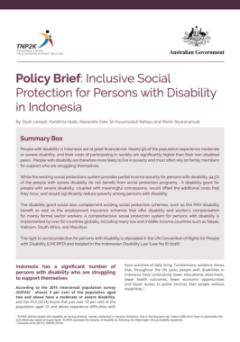
Policy Brief: Inclusive Social Protection for Persons with Disability in In…
According to the 2015 intercensal population survey (SUPAS)1 almost 9 per cent of the population aged two and above have a moderate or severe disability, and the IFLS (2014) found that just over 10 per cent of the population aged 15 and above experience difficulties with basic activities of daily living. Furthermore, evidence shows that, throughout the life cycle, people with disabilities in In…
- Edisi
- 1
- ISBN/ISSN
- -
- Deskripsi Fisik
- PDF, 8 Halaman
- Judul Seri
- Policy Brief
- No. Panggil
- 371.9 LAR.P

Disability Situation Analysis Challenges and Barriers for People with Disabi…
People with disability in Indonesia are not only at great economic and financial risk but are also facing great challenges in accessing health and education facilities and services, social protection, and in entering the labour market. In 2018, the Indonesia National Socio-Economic Survey (Susenas) included the Washington Group Disability Questions Set5 which aims to provide the most updated in…
- Edisi
- 1
- ISBN/ISSN
- -
- Deskripsi Fisik
- PDF, 16 Halaman
- Judul Seri
- Policy Brief
- No. Panggil
- 371.9 SIY.D
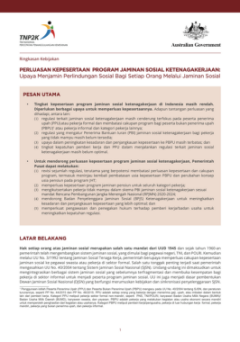
Ringkasan Kebijakan PERLUASAN KEPESERTAAN PROGRAM JAMINAN SOSIAL KETENAGAKE…
Hak setiap orang atas jaminan sosial merupakan salah satu mandat dari UUD 1945 dan sejak tahun 1960-an pemerintah telah mengembangkan sistem jaminan sosial, yang dimulai bagi pegawai negeri, TNI, dan POLRI. Kemudian melalui UU No. 3/1992 tentang Jaminan Sosial Tenaga Kerja, pemerintah berupaya memperluas cakupan kepesertaan jaminan sosial ke pegawai swasta atau pekerja di sektor formal. Sala…
- Edisi
- 1
- ISBN/ISSN
- -
- Deskripsi Fisik
- PDF, 12 Halaman
- Judul Seri
- Policy Brief
- No. Panggil
- 368.4 MIL.R
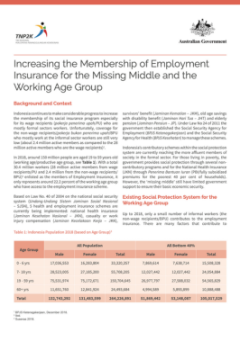
Increasing the Membership of Employment Insurance for the Missing Middle and …
Indonesia continues to make considerable progress to increase the membership of its social insurance program especially for its wage recipients (pekerja penerima upah/PU) who are mostly formal sectors workers. Unfortunately, coverage for the non-wage recipients/pekerja bukan penerima upah/BPU who mostly work at the informal sector workers are still very low (about 2.4 million active members as …
- Edisi
- 1
- ISBN/ISSN
- -
- Deskripsi Fisik
- PDF, 2 Halaman
- Judul Seri
- Policy Brief
- No. Panggil
- 368.4 LAR.I

Policy Brief: Expansion Of Social Insurance For Employment Program: Efforts …
The right of every person to social security is a mandate of the 1945 Constitution and, since the 1960s the GoI has embarked on developing a social security system. Initial coverage extended to civil servants, members of the military, and police. Through enactment of Law No. 3/1992 on Social Insurance for Employment, the government later sought to expand coverage of social security to privat…
- Edisi
- -
- ISBN/ISSN
- -
- Deskripsi Fisik
- PDF, 12 Halaman
- Judul Seri
- Policy Brief
- No. Panggil
- 368.4 MIL.E
 Karya Umum
Karya Umum  Filsafat
Filsafat  Agama
Agama  Ilmu-ilmu Sosial
Ilmu-ilmu Sosial  Bahasa
Bahasa  Ilmu-ilmu Murni
Ilmu-ilmu Murni  Ilmu-ilmu Terapan
Ilmu-ilmu Terapan  Kesenian, Hiburan, dan Olahraga
Kesenian, Hiburan, dan Olahraga  Kesusastraan
Kesusastraan  Geografi dan Sejarah
Geografi dan Sejarah